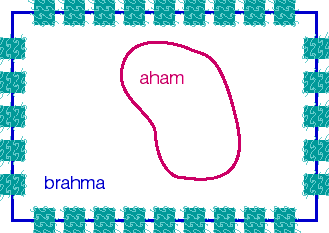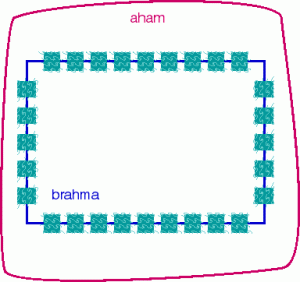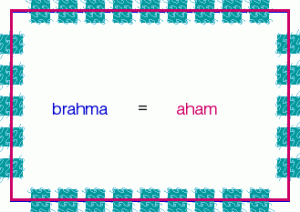|
brahma is the sanskrit word for all that is.
Not all that exists, but all that is. I am that I am – Yahweh For example, let’s say the words “purple zebra”. A purple zebra doesn’t exist, as far as we know, but it IS, because it is in your head right now. Sort of like a black swan. A “black swan” was a word/concept used in medieval Europe to describe something that didn’t exist. Then, when the Europeans went to Australia, lo and behold, there were actual black swans. So brahma is all that is, whether we know it to presently exist or not. You can deify brahma if you want, and give it a Personage, so that you would call it Brahma with a capital B, but you don’t have to. Here, it is “simply” the word for all that is. Clearly, you are part of brahma. In particular I know at least that I am a part of brahma. aham means I in sanskrit but you can insert your name here. The box is dashed because the box, usually reserved for the Universal Set, implies there is something outside of the box, whereas brahma is not just the box on your screen, but your screen, the county it is in, the country, the galaxy, the universe, and perhaps, all universes. So the universal set is porous and hence dashed. Thus, we have “aham is a subset of brahma.” Hopefully, that’s not too hard to cognize. Yoga teaches us what can be a surprising thing: all of everything is a subset of us. The kingdom of heaven is within you. – Jesus As you do to the least of these you do unto me. – Jesus sarvabhuutastham aatmaaanam sarvabhuutaani caatmaniiksate He sees the Self in all beings, and all beings in the Self. (Bhagavad Giitaa, 6.29) So “brahma is a subset of aham.” If aham is a subset of brahma and brahma is a subset of aham, then the only mathematical conclusion is that aham IS brahma. We ARE the porous “box” of everything that is. One picture becomes the next. In sanskrit, this is said by the ancient inestimable phrase: “aham brahmAsmi”, which simply means “I am brahma.” To explain this further I like this quote: The concept of unity is used to cancel the concept of the many; the concept of self (infinite consciousness) is used to cancel the conceptualisation of unity. [The term “unity” itself implies disparate objects. Ed.] The self can neither be conceived of as existence or non-existence, it is what is. (Vasistha’s Yoga, p. 400) You are what is. Truly, Om tat sat. (Thou art that.) “A double-minded man is unstable in all his ways,” says the Book of James
Yama, niyama, Asana, prANAyAma, pratyAhAra, dhAraNA, dhyAna, and samAdhi are the eight limbs [of yoga]. Yoga Sutras, II.29 I’ve recently been in something like love with the concept of dhAraNA, “focusings”, that leads to an incredibly important quality, steadiness. Steadiness sounds rather dry, doesn’t it? It’s yet another concept that I didn’t process very deeply at first in the Sutras. I think it gave it short shrift: “Yeah, yeah, yeah. I know. I need steadiness.” Yet I’ve come in the past 6 months to really come to know and appreciate steadiness if not to have wonderful amounts of it. As Shree Karunamyi says, “How can you drive on the interstate [of life] and not have steadiness? You’ll get in an accident.” It takes me awhile to appreciate even the beginnings of what the Greats have to say, and so it was with the above. Focusing (dhArANa) fully deserves its place as a full limb – equal with Asana – of yoga, and one of the three distinct inner limbs that together – dhAraNA, dhyAna, and samAdhi – are the definition of the all important siddhi “perfect regulation of citta [consciousness]” or sanyama. The Sutras even tell us how to acheive steadiness through sanyama on the “subtle channel in the shape of a tortoise in the chest below the throat pit”. (III.31) I’m just beginning to appreciate steadiness in my own life. It’s really been a theme lately. It’s amazing how much even a little bit of can improve a situation. I feel like I’ve finally discovered a key to my own life, only one of many available to a hyper-dimensional door, but it is so powerful that I just wanted to say a little about it. In Ayurveda, copper drinking vessels are suggested for the dinacharya (daily rituals) of the yogi, as well as the material of choice for items of complex rituals and pancha karma.
This study may indicate why: A study found that copper fittings rapidly killed bugs on hospital wards, succeeding where other infection control measures failed. In the trial at Selly Oak hospital, in Birmingham, copper taps, toilet seats and push plates on doors all but eliminated common bugs. It is thought the metal ‘suffocates’ germs, preventing them breathing. It may also stop them from feeding and destroy their DNA. Lab tests show that the metal kills off the deadly MRSA and C difficile superbugs. It also kills other dangerous germs, including the flu virus and the E coli food poisoning bug. RSis once again prove they know their stuff. |
ARTICLESAuthorRenay Oshop - teacher, searcher, researcher, immerser, rejoicer, enjoying the interstices between Twitter, Facebook, and journals. Categories
All
Archives
September 2023
|
© 2008–2024 Renay Oshop AyurAstro®




 RSS Feed
RSS Feed